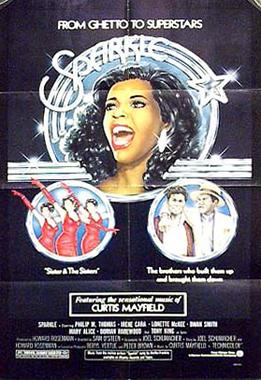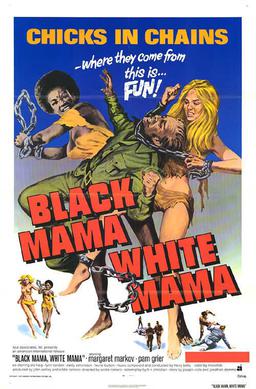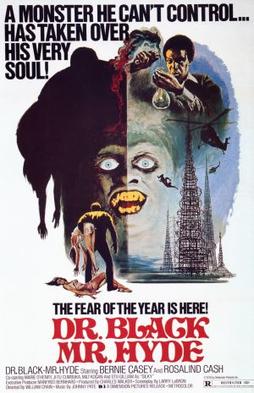
Shaft is a 1971 American blaxploitation crime action thriller film directed by Gordon Parks and written by Ernest Tidyman and John D. F. Black. It is an adaptation of Tidyman's novel of the same name and is the first entry in the Shaft film series. The plot revolves around a private detective named John Shaft who is hired by a Harlem mobster to rescue his daughter from the Italian mobsters who kidnapped her. The film stars Richard Roundtree as Shaft, alongside Moses Gunn, Charles Cioffi, Christopher St. John and Lawrence Pressman.

An exploitation film is a film that tries to succeed financially by exploiting current trends, niche genres, or lurid content. Exploitation films are generally low-quality "B movies", though some set trends, attract critical attention, become historically important, and even gain a cult following.

Shampoo is a 1975 American comedy film directed by Hal Ashby, and starring Warren Beatty, Julie Christie, Goldie Hawn, Lee Grant, Jack Warden, Tony Bill, and Carrie Fisher in her film debut. Co-written by Beatty and Robert Towne, the film follows a promiscuous Los Angeles hairdresser on Election Day 1968, as he juggles his relationships with several women. The film is a satire focusing on the theme of sexual politics and late-1960s sexual and social mores.

Final Justice is a 1985 Italian-American action film directed, produced and written by Greydon Clark, and stars Joe Don Baker as a Texas sheriff who overturns a Maltese city to find the mobster who killed his partner.

Mandingo is a 1975 American historical melodrama film that focuses on the Atlantic slave trade in the Antebellum South. The film's title refers to the Mandinka people, who are referred to as "Mandingos", and described as being good slaves for fighting matches. Produced by Dino De Laurentiis for Paramount Pictures, the film was directed by Richard Fleischer. The screenplay, by Norman Wexler, was adapted from the 1957 novel Mandingo by Kyle Onstott, and the 1961 play Mandingo by Jack Kirkland.

Foxy Brown is a 1974 American blaxploitation film written and directed by Jack Hill. It stars Pam Grier as the title character who takes on a gang of drug dealers who killed her boyfriend. The film was released by American International Pictures as a double feature with Truck Turner. The film uses Afrocentric references in clothing and hair. Grier starred in six blaxploitation films for American International Pictures.

Sparkle is a 1976 American musical drama film directed by Sam O'Steen and released by Warner Bros. Pictures. With a plot inspired by the history of the Supremes, Sparkle is a period film set in Harlem, New York, during the late 1950s and early 1960s. It presents the story of a musical girl group that ends up breaking apart due to individual issues each member faces. This film not only "recreates the magic of a special period in American history, but it explores the effect of Harlem's musical and social culture on the rest of the world," as well as the linkages to black power.

Cleopatra Jones is a 1973 American blaxploitation film directed by Jack Starrett. Tamara Dobson stars as an undercover government agent who uses the day job of supermodel as her cover and an excuse to travel to exotic places. Bernie Casey, Shelley Winters and Antonio Fargas also feature. The film has been described as being primarily an action film, but also partially a comedy with a spoof tone.

Willie Dynamite is a 1973 American blaxploitation film directed by Gilbert Moses and starring Roscoe Orman, Diana Sands, Thalmus Rasulala, Joyce Walker, and was released by Universal Pictures. The eponymous Willie Dynamite is a pimp in New York City, who strives to be number one in the city. As he is trying to do so, a social worker named Cora, is trying to change his ways - as well as those of the women who work for him - for the better. It was the first film produced by the Zanuck-Brown Company.

Three the Hard Way is a 1974 action film directed by Gordon Parks Jr., written by Eric Bercovici and Jerrold L. Ludwig, and starring Fred Williamson, Jim Brown, and Jim Kelly.
Stephen C. Apostolof, sometimes credited under aliases A.C. Stephen(s) or Robert Lee, was a Bulgarian-American filmmaker specializing in low-budget exploitation and erotic films, who gained a cult following for a wide variety of films that range from erotic horror and suburban exposé to western-themed costume pictures and Mission Impossible-type capers such as. Apostolof had gained a reputation for creating high-quality mass entertainment with minimal budgets. He was also one of the few directors to work steadily with the infamous Ed Wood and such sexploitation icons as Marsha Jordan and Rene Bond in the 1960s and 1970s.

Black Mama White Mama, also known as Women in Chains, Hot, Hard and Mean and Chained Women, is a 1973 women in prison film directed by Eddie Romero and starring Pam Grier and Margaret Markov. The film has elements of blaxploitation.

Dr. Black, Mr. Hyde is a 1976 blaxploitation horror film loosely inspired by the 1886 novella Strange Case of Dr. Jekyll and Mr. Hyde by Robert Louis Stevenson. The film stars Bernie Casey and Rosalind Cash, and was directed by William Crain. Along with Crain, and it was written by Larry LeBron and Lawrence Woolner with cinematography by Tak Fujimoto. It was filmed primarily in Los Angeles, at locations such as the Watts Towers.
Tanya Boyd is an American actress who is best known for her role as Celeste Perrault on Days of Our Lives.

Black Snake is a 1973 American film directed by Russ Meyer and starring Anouska Hempel, David Warbeck, Percy Herbert and Thomas Baptiste. It was Meyer's return to self-financed projects, following the end of his brief deal at 20th Century Fox. Meyer's only attempt at the Blaxploitation genre, it was filmed in Panavision and was shot on location in Barbados. It was such a box office bomb that a film named Foxy starring Edy Williams, which Meyer wanted to follow this film, was not made.

Blaxploitation is an ethnic subgenre of the exploitation film that emerged in the United States during the early 1970s, when the combined momentum of the civil rights movement, the Black power movement, and the Black Panthers spurred black artists to reclaim power over their image, and institutions like UCLA to provide financial assistance for students of color to study filmmaking. This combined with Hollywood adopting a less restrictive rating system in 1968. The term, a portmanteau of the words "black" and "exploitation", was coined in August 1972 by Junius Griffin, the president of the Beverly Hills–Hollywood NAACP branch. He claimed the genre was "proliferating offenses" to the black community in its perpetuation of stereotypes often involved in crime. After the race films of the 1940s and 1960s, the genre emerged as one of the first in which black characters and communities were protagonists, rather than sidekicks, supportive characters, or victims of brutality. The genre's inception coincides with the rethinking of race relations in the 1970s.
Blaxploitation horror films are a genre of horror films involving mostly black actors. In 1972 director William Crain did the first blaxploitation horror film, Blacula.

The Bad Bunch is an American 1973 blaxploitation drama film directed by and co-starring Greydon Clark.

Evils of the Night is a 1985 American science fiction horror film starring Aldo Ray, Neville Brand, Tina Louise, John Carradine, and Julie Newmar. The film was directed, co-produced and co-written by Mardi Rustam.
Johnathan Daniels, known professionally as John Daniels, is an American former actor, songwriter, producer and club owner.
















